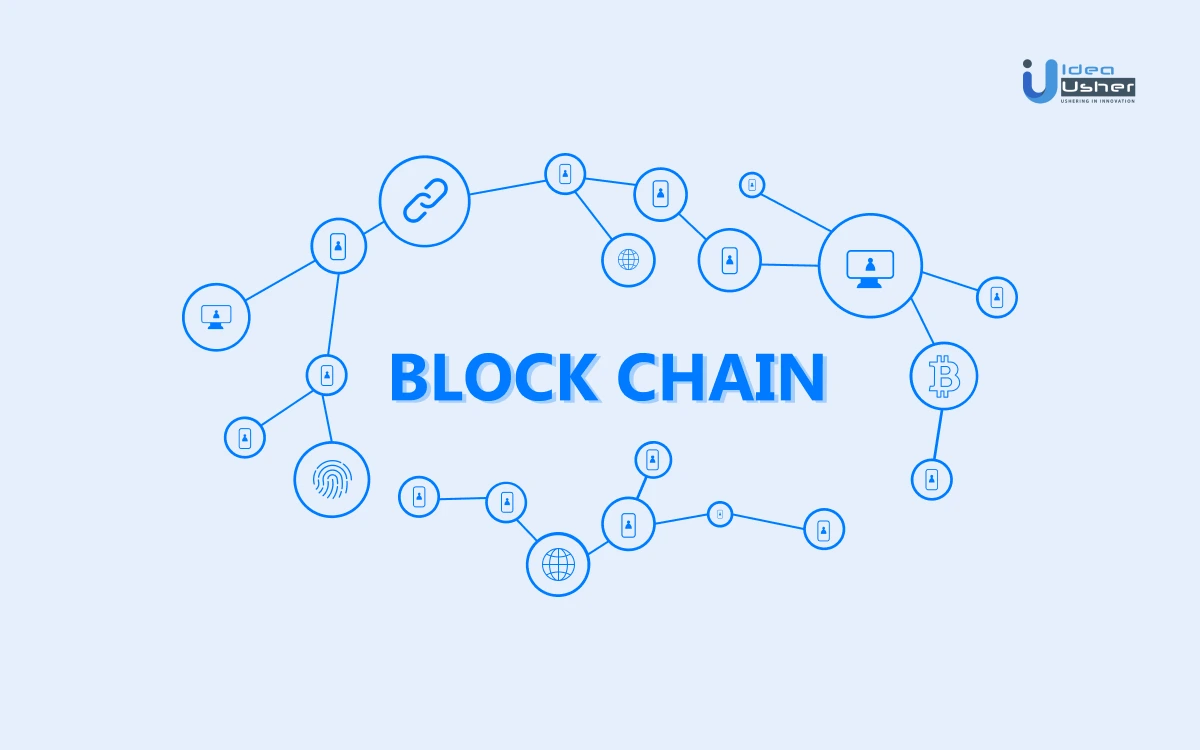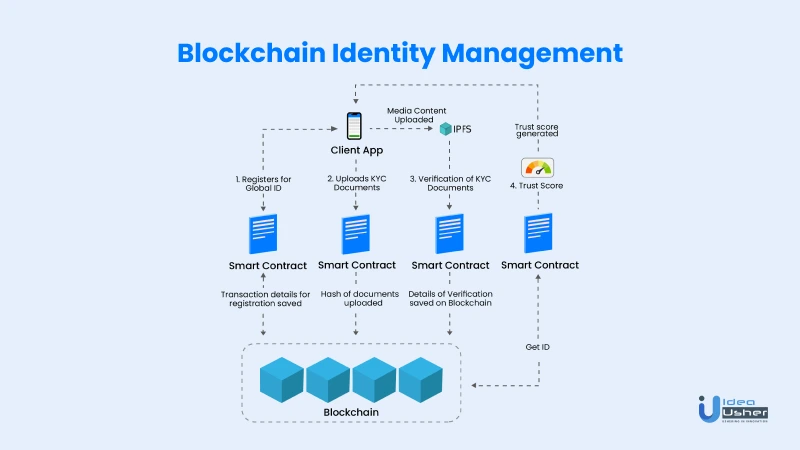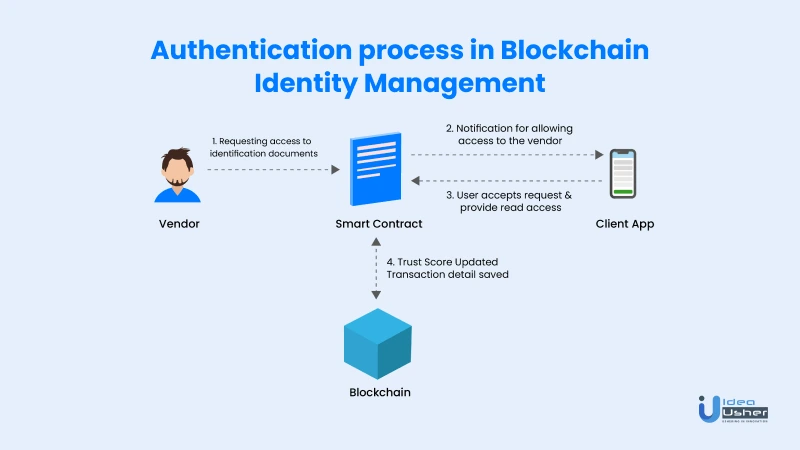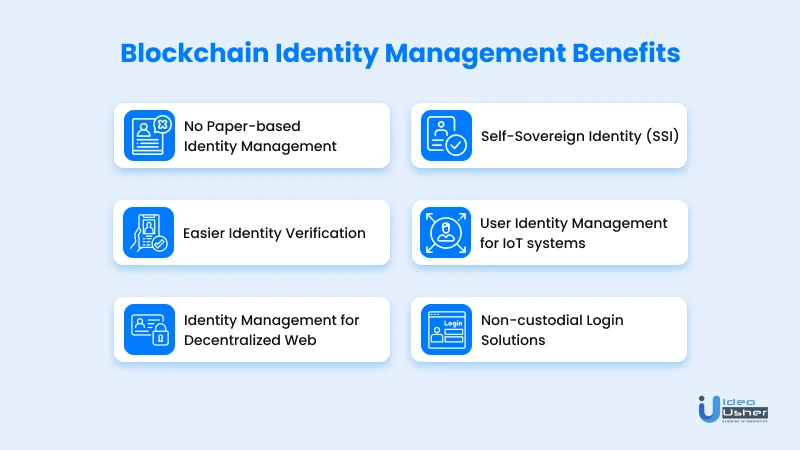- What is Blockchain Identity Management?
- What are the challenges that exist in the traditional identity management system?
- How does Blockchain Identity Management work?
- What is the trust score? How does it work?
- Benefits of Blockchain Identity Management
- Where can Blockchain Identity Management be applied?
- Contact Idea Usher for Blockchain Solutions
- Final Words
- Frequently Asked Questions

Industry 4.0 has brought about many changes in the world as organizations are focusing on creating intelligent systems using artificial intelligence and machine learning. Besides, organizations have also started emphasizing ‘Blockchain Identity Management’ and have started thinking about its various aspects.
“How does blockchain identity management work?” “What are its benefits?” “Where can it be applied?”
This blog answers all these questions.
The traditional identity management system poses many severe threats and concerns, which has led to blockchain-based identity management becoming more relevant.
- What is Blockchain Identity Management?
- What are the challenges that exist in the traditional identity management system?
- How does Blockchain Identity Management work?
- What is the trust score? How does it work?
- Benefits of Blockchain Identity Management
- Where can Blockchain Identity Management be applied?
- Contact Idea Usher for Blockchain Solutions
- Final Words
- Frequently Asked Questions
What is Blockchain Identity Management?
Blockchain identity management refers to the set of processes that an organization puts in place to identify, authenticate, and authorize a person using blockchain to access the organization’s services or systems.
Blockchain provides unified, interoperable, and tamper-proof infrastructure, thus enabling organizations to have a more secure and reliable identity management system.
As a significant part of digital identity management, blockchain has benefitted multiple businesses by replacing traditional identity management systems.
What are the challenges that exist in the traditional identity management system?
Here are 6 challenges that plague traditional identity management systems:
1. Cumbersome User Lifecycle Management
Adding, modifying, and deleting user accounts across various systems can be a complex and time-consuming process for IT administrators. Traditional systems often lack automation, leading to delays and potential security vulnerabilities during provisioning and de-provisioning.
2. Siloed Access Control
Many organizations have separate access control mechanisms for different applications and databases. This fragmented approach makes it difficult to manage user permissions centrally and enforce consistent security policies. Users might also end up juggling numerous login credentials for various systems.
3. Poor User Experience
Traditional systems often rely on static passwords and knowledge-based authentication, which can be frustrating for users to remember and manage. Additionally, resetting forgotten passwords can be a cumbersome process for both users and IT support.
4. Limited Scalability
As organizations grow and the number of users and applications expands, traditional IAM systems can struggle to keep up. Adding new users or integrating new applications can be a complex and resource-intensive task.
5. Susceptibility to Identity Theft
Traditional systems with static credentials are vulnerable to brute-force attacks, phishing scams, and credential stuffing. A data breach compromising usernames and passwords can have a significant impact, granting unauthorized access to sensitive data.
6. Compliance Challenges
Meeting regulatory compliance requirements can be difficult with traditional IAM systems. Detailed audit trails and granular access controls may not be readily available, making it challenging to demonstrate adherence to data privacy regulations.
How does Blockchain Identity Management work?
A blockchain-based identity management system involves five technical components:
- Native Android/iOS app for individuals
- Native Android/iOS app for verification companies
- Interplanetary File System (IPFS) to store the user’s Personally Identifiable Information (PII)
- Microservices programmed using Node.js
- Permissioned blockchain component

Steps involved in Blockchain Identity Management:
1. Mobile App Installation
The first step is to download the identity management app to establish an individual’s identity.
The user needs to create a profile on the app, post which they will receive a unique ID number that the organization will use to access the user’s identification documents.
2. Document Upload
The next step is to upload the documents on the app.
The users need to upload the government-issued IDs that the IPFS will store with hashed addresses stored in the blockchain. Later, the app extracts the user’s PII for self-certification.
Another thing to note is that the users do not lose ownership of the data and can control which information is to be shared.
3. Generation of Trust Score
A trust score is a score showcasing the trustworthiness of an individual. It helps organizations to determine whether an account is valid or suspicious.
Various factors like the number of documents uploaded, matching information across documents, and regular system use boost the user’s trust score.
Moreover, smart contracts containing business logic create the user’s trust score.
4. Access requests from Verification Companies
Suppose a company wants to access a user’s information for authentication. In that case, they need to put in the unique ID number of the user, which will send a notification to the user’s mobile phone.
The company can access the user’s PII only after they allow the company to do so. Also, the user can trace the purpose of PII use.
The blockchain doesn’t store the user’s PII. It stores only the records of the transactions between the company and the user.
The following flow chart can better explain this step.

What is the trust score? How does it work?
In blockchain identity management, a trust score acts like a digital reputation meter for your identity. It’s a numerical representation of your trustworthiness within the system, calculated by smart contracts based on your interaction and information. A higher score signifies a more reliable and verified identity. This score can streamline online transactions and interactions by offering a quick assessment of your credibility.
So, how does this trust score work? Here’s a breakdown in 3 steps:
- Building Your Identity: You start by creating a profile and uploading verifiable documents like government IDs or diplomas. The system checks these documents for authenticity, and each verified document contributes positively to your initial score.
- Maintaining Consistency: The system also analyzes the consistency of information across your uploaded documents. The more consistent your details (like name and date of birth) are, the higher your score climbs. Regular use of the identity management system can further boost your score, indicating active participation.
- Reputation Through Interactions: Beyond initial documents, some blockchain identity systems consider your past interactions on the platform. Positive interactions, like completing transactions successfully, can further elevate your score. Conversely, negative interactions or suspicious activity might lower it. This dynamic aspect encourages responsible behavior within the system.
Benefits of Blockchain Identity Management

1. No Paper-based Identity Management
When an individual loses their original ID proof, they need to go through a lot of formalities to get the duplicate ID proof document.
The government stores the data in paper form and relies on manual processes, thus delaying the process of obtaining the duplicate ID proof.
Blockchain solves this problem by eliminating paper use and manual processes and storing the information digitally. So, the government can keep the individual’s ID proof on the blockchain.
The information recorded on the blockchain is permanent and tamper-proof, ensuring safety and reliability. So when a person loses an ID proof, the government can quickly provide the duplicate ID without going through the cumbersome process of searching piles of files.
2. Self-Sovereign Identity (SSI)
Self-Sovereign Identity (SSI) refers to the concept that individuals can store their PII on their own devices and have complete ownership and control over their information.
If a third party wishes to access the identity information, it can do so only after the primary user grants permission. Thus, the use and disclosure of data are in the hands of the user, and there is no need to depend on a third-party service provider.
The permanency of SSI makes it immune to hackers. Similarly, its portable nature makes it convenient for the user.
For example, Hyperledger Indy is an enterprise framework that uses blockchain to cater to digital identity use cases.
3. Easier Identity Verification
The existing manual processes can make the identity management solutions a little complex. However, blockchain-based identity management solutions can help overcome such challenges.
An example of a blockchain startup that offers identity management solutions is Blockpass.
Such platforms have a blockchain-based KYC portal where the identity is verified. This portal helps businesses to follow strict KYC regulations. Companies also use this portal for their user onboarding.
The platform also provides easy-to-install tools, and it uses smart contracts for KYC and Anti-Money Laundering (AML) compliance.
Entrepreneurs can use such platforms for identity management or blockchain platforms like Ethereum to develop their Decentralized Apps (DApps).
4. User Identity Management for IoT Systems
The Internet of Things is growing and is invading almost every sector, be it fitness, health, agriculture, or housing. IoT-enabled devices collect and transmit the data to the service providers via the internet, thus leading to a security risk.
Many IoT-enabled devices collect sensitive information related to health and other personal details. Thus, it is essential to protect this information from theft and hacking.
In this case, blockchain comes to the rescue as it gives the users complete control and ownership of their data. They can control which information to share with the IoT-enabled devices.
5. Identity Management for Decentralized Web
Various third-party services, such as Internet service providers, track online activities, such as user site visits. They can do this because they have access to the user’s information.
As a result, the users are transitioning towards a decentralized web where they do not have to provide their personal information.
An appropriate digital identity management solution is of utmost importance here. The users should be able to access the services with a single digital identity. Besides, they should also have the liberty to choose with whom they want to share their information.
Blockchain-based identity management allows the users to do this. They can store their digital IDs on the blockchain, and the service providers can access them for authentication purposes.
6. Non-custodial Login Solutions
A custodial login solution refers to when the responsibility of keeping a user’s data safe is in the hands of third parties. They do so by storing the information on a central server. This central server is vulnerable to hacking and is a lucrative source for hackers.
Blockchain can change this situation by having features like decentralization and enhanced security. These solutions do not use central servers; instead, they use a combination of a public-private key to log in.
For instance, platforms like Remme provide such non-custodial login solutions.
Where can Blockchain Identity Management be applied?

There are various areas where individuals and organizations can apply blockchain-based identity management solutions to full advantage. Some of them are listed below.
1. Immigration
A traveler needs to carry various documents and ID proofs for security checks at airports. The airports can streamline their processes if the traveler shows a single blockchain-based identity at multiple points.
They do not have to go through the cumbersome process of showing different ID proofs at different security checkpoints. Thus, the process becomes easier for the travelers and the authorities.
2. E-commerce Checkout
While shopping on an e-commerce platform, a user needs to fill in various details like name, address, phone number, email address, etc. The user has to repeat the same process to sign up for another e-commerce platform, making the process repetitive and tiring.
With blockchain-based identity management in place, the user can put the unique ID number on whichever e-commerce platform they want to sign up on, thus saving time and effort.
3. Loan Application
Traditionally, to apply for a loan or open a new bank account, an individual must submit various identity documents. Manual verification takes a lot of time to complete and delays the loan grant to the individual.
Blockchain-based identity management can speed up the process as the individual doesn’t have to maintain different identity documents. Instead, they can use a single identity document stored on the blockchain to make the loan available.
4. Legal Procedures
An individual must submit different ID proofs like age proof, address proof, occupation proof, etc., for any legal process. With a single ID stored on the blockchain, the individual doesn’t need to carry multiple documents. Also, comprehensive background checks of the individual are no longer required.
Contact Idea Usher for Blockchain Solutions
Blockchain offers several advantages to organizations and individuals. They make the processes more accessible and, at the same time, provide greater security to the user’s identity.
An organization can save time and effort if it switches from a traditional identity management system to a blockchain-based one. Also, it is essential to properly integrate blockchain technology within the organization’s functioning to take full advantage of digital identity management.
Thus, hiring experts for this task becomes crucially important. Idea Usher has expertise in providing various blockchain-related services to its clients to help them grow and make their business processes more efficient.
Get in touch with Idea Usher and take your business to the next level.
Final Words
With the world advancing with each passing day, organizations have started realizing the problems that the traditional modes of functioning bring along. There is an increasing awareness regarding data security and efficient processes.
Thus, more and more organizations are switching from traditional functioning methods to newer, more advanced, and secure ways. The same has happened in the case of identity management too.
The problems faced by organizations with traditional identity management led them to adopt blockchain-based identity management solutions, thus making it easier for individuals and organizations to record and store ID information.
To sum up, blockchain technology provides a safer, quicker, and more convenient solution for identity management. A large number of organizations will likely adopt this technology in the coming years.
Frequently Asked Questions
Q. What is blockchain identity management?
A. Imagine a secure digital wallet for your identity! Blockchain identity management stores your credentials on a tamper-proof network, giving you control over who sees what. You can easily share verified information without the risk of data breaches.
Q. Can blockchain be used for identity?
A. Absolutely! Traditional identity systems are fragmented and vulnerable. Blockchain offers a secure, decentralized way to manage your digital identity, empowering you with greater privacy and control.
Q. What is identity as a service using blockchain?
A. Think of it as a one-stop shop for your identity needs. Blockchain-based identity as a service lets you create, store, and share verified credentials online. No more juggling multiple logins or relying on centralized servers.
Q. Which blockchain platform is known for identity verification and authentication?
A. Several platforms are making waves in this space. Ethereum, for example, is a popular choice for building decentralized identity applications due to its smart contract functionality.













Mayank Sharma